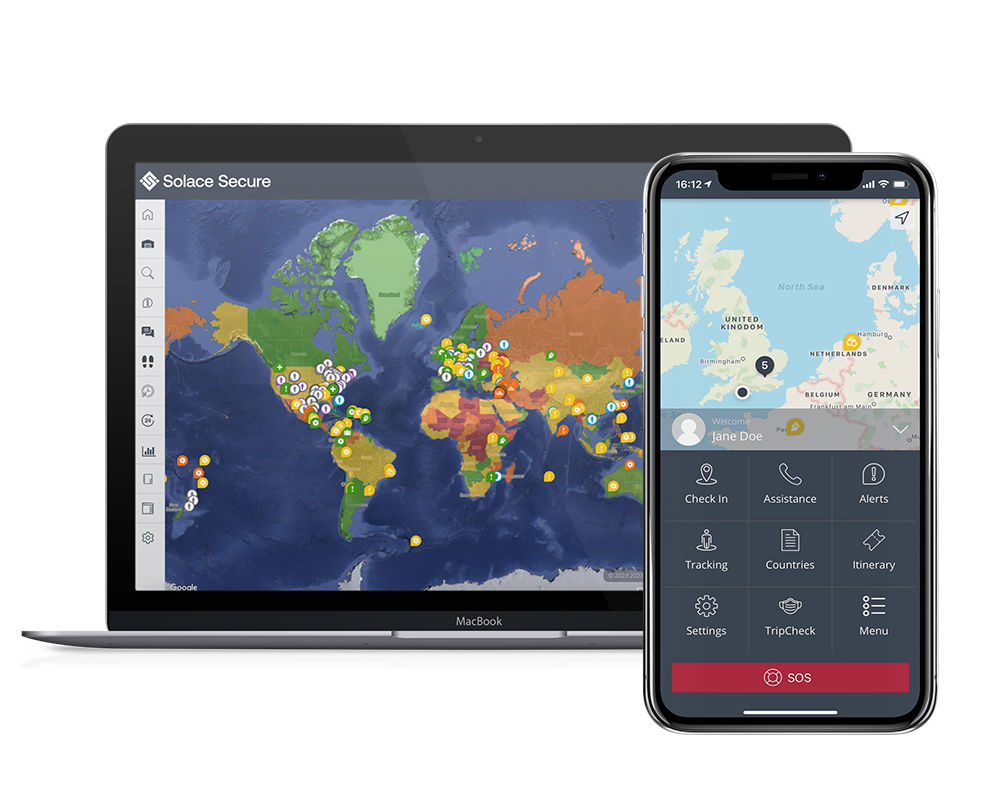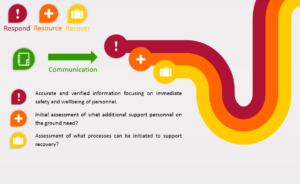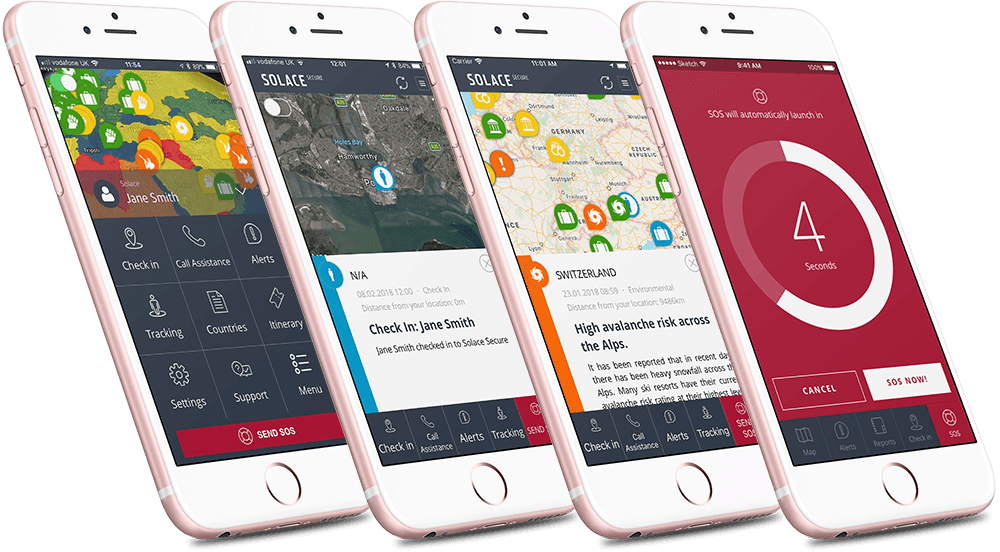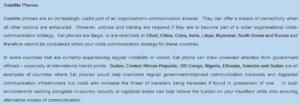
Information; Communication; the First Steps to Resilience
25 Jan 2019
Central to a businesses’ duty of care, as well as their wider reputation, is the capability to make informed, quick and decisive responses in the event of a natural hazard, that not only protects their stakeholders but minimises the impact on their operations. Mobile employees are acutely vulnerable to the impact of a natural hazard due to their unfamiliarity with the environment, lack of local language skills and limited local social network, making the need to prepare staff on what to do in a crisis essential. Policies and procedures should be adopted that can rapidly locate and contact mobile employees while also providing accurate and time-sensitive information to support an appropriate response.
KEY POINTS
- Central to a businesses’ duty of care, as well as their wider reputation, is the capability to make informed, quick and decisive responses in the event of a natural hazard, that not only protects their stakeholders but minimises the impact on their operations.
- Mobile employees are acutely vulnerable to the impact of a natural hazard due to their unfamiliarity with the environment, lack of local language skills and limited local social network, making the need to prepare staff on what to do in a crisis essential.
- Policies and procedures should be adopted that can rapidly locate and contact mobile employees while also providing accurate and time-sensitive information to support an appropriate response.
SITUATIONAL SUMMARY
On 28 September at 15.00 (Indonesian Central Standard Time) a 7.5 magnitude earthquake struck Sulawesi Island in Indonesia, 50km from Palu town, a popular backpacker destination. Several minutes after the first reports of the earthquake organisations were receiving calls from employees situated throughout Indonesian archipelago. While most foreign personnel were situated outside the impact area, a small number of organisations received calls from staff situated in Palu town. Communication from staff in the affected area triggered a pre-approved and coordinated response plan that worked to ensure appropriate and time-sensitive decisions were made to protect those on the ground.
In one example, after the initial assessment was conducted, personnel on the ground were instructed to move inland and seek shelter in a building away from the coast where they were be met by a local logistics provider. Half an hour later a Tsunami struck Palu.
The decision to move staff inland was part of a pre-approved response plan that sought to provide end-to-end assistance to employees affected by a natural hazard. Processes were built around the capability of organisations to swiftly assess the situation on the ground and communicate this to relevant stakeholders. By capturing real time and accurate information from a range of sources and communicating this information to the main stakeholders, the safest and best course of action was taken to minimise the risk of harm.
The two most critical elements when responding to any crisis are communication and information and when these factors are incorporated into a ‘living’ or dynamic response plan, organisation are best positioned to provide adequate and timely support to travelling employees in line with their duty of care responsibilities. Both elements become increasingly more difficult to manage in the event of a natural hazard and require greater attention and contingencies when planning travel to at-risk locations.
INTRODUCTION
In an ever more interconnected global economy, businesses are increasingly operating overseas. As the number of mobile employees grows, so does the legal and moral obligation to protect the wellbeing of such staff from the increased threat posed by operating abroad in hazard prone locations. The Solace Global pilot advisory, Building Operational Resilience to Natural Hazards, started to explore some key themes around how business can implement safer travel safety policies and procedures for their staff when visiting locations susceptible to natural hazards. This report will look in-depth at the importance of information and communication when mobile employees are situated in the proximity of a crisis event (specifically a natural hazard).
When any critical incident occurs where staff are located, the immediate priority of an organisation is to make positive contact with their employees, ensure the safety of those in the affected area, pass on critical information, activate additional resources if needed and if feasible begin the recovery process. Information remains the most valuable commodity during this process, providing the basis for effective decision making.
CASCADING HAZARDS AND DYNAMIC INFORMATION
A geological or meteorological event, such as an Earthquake, acts as a catalyst, triggering multiple hazards that are linked to the environment in which the event occurred. For example, when a major seismic event takes place in a certain location it could result in a breakdown of basic infrastructure. This failure in infrastructure might result in visible and easily discernible impacts such as building damage or the immediate loss of telecommunications systems. Impacts can also be unseen, such as the contamination of water sources; resulting in disease outbreak. Cascading hazards refers to the process in which hazards interact often producing a multiplying effect. They require dynamic information management to work alongside effective communication strategies. Processes must work concurrently, be informed by specialists and lead to clear advice that those in-country can easily implement.

Crisis communication aims to prevent or lessen negative outcomes by ensuring those individuals in the affected area have accurate and verifiable information that can support effective decision making. The correct information will lessen the threat to your employees by enabling those on the ground to make informed decisions to reduce their initial risk while also implementing actions to promote business continuity and recovery.
When managing the security and safety of employees who are operating overseas in hazard-prone areas, communication and information systems have never been more important and remain the responsibility of the sending organisations. National disaster management systems are built for local citizens and often will not support expatriates and foreign travellers who do not have a command of the local language and understanding of existing civic and government response systems. Therefore, organisations with employees operating in regions have a responsibility to ensure they quickly assume the role of managing information and communication with those staff on the ground.
Establishing Principles and Standards for Information Management in Emergency (RAVO)
Information is critical to response; however, changes in the way media and information are disseminated, often via social media, the ability to provide accurate information has become increasingly more challenging. Principles should help guide information management functions to support an accurate internal response in disaster or emergency situations.
- Relevance: Information should be practical, flexible, responsive and driven by operational and decision-making needs throughout the duration of the crisis. Geographical relevance is also essential, if in one part of a country too often trigger crisis management plans for personnel based in a different part of the country that is unaffected – thus lessening the impact and relevance of crisis information and promoting a les affaires approach from deployed personnel when receiving alerts.
- Accountability: Evaluate the reliability and credibility of information being passed to stakeholders, taking ownership for the content published and disseminated.
- Verifiable: Information should be accurate, consistent and based on sound specialist knowledge. It should be then validated by comparing with approved external sources and analysed within a non-biased contextual framework.
- Objectivity: Information managers should consult a variety of sources when collecting and analysing information to provide a varied and balanced perspective, informing operational response and decision making throughout the crisis – from the response to the recovery phase.
Initial information is essential to put in place steps to minimise the threat to individuals in the affected area. It is also important that, if safe to do so, staff on the ground initiate the recovery and continuity processes as quickly as possible. Precise and accurate information is essential to achieving both processes safely. The initial steps taken by personnel affected by a natural hazard are often guided by their own training and understanding of the threat, enabling them to conduct a visual risk assessment and take immediate action, however, natural hazards present dynamic, constantly shifting threats that are either unknown or poorly understood. Therefore, those affected by the crisis, need to be supported with accurate information communicated in a time sensitive manner.

(Figure 3: Solace Global Respond, Resource, Recovery Crisis Framework)
A LAYERED APPROACH TO COMMUNICATION
The first 24 – 48 hours following any natural hazard is the window in which communication and information are essential for assessing and responding to a hazard event. It is also the key period in which lives are saved and therefore organisations with staff operating internationally have a duty to have communication strategies in place to quickly make positive contact with employees and relay critical information to those operating in the affected area. However, communication networks are susceptible to breakdown following a hazard event. On numerous occasions, natural events have led to catastrophic damage to mainstream communication networks including telecommunications as well as internet-based communication methods, meaning that strategies must be considered to ensure that multiple, context-specific communication methods are available to staff who are travelling overseas.

Layering communication approaches support building an organisations resilience to potential communication shocks following any crisis. Living in an age of communication it is vital to remain on top of new technologies, constantly seeking to improve organisational capability to communicate in situations where normal channels are disrupted. Telecommunications is fast becoming a secondary means of communication due to its fragility and cost. Voice Over Internet Protocol (VOIP) alongside internet-based messenger services are increasingly providing a more robust technology for conducting communication in a disaster. Networks can be quickly and easily set up either through minimal wired internet service or by utilising mobile broadband products. Internet communications came to prominence after the Izmit earthquake in 1999 when telecommunications infrastructure was destroyed by the 7.5 magnitude quake. The response to the incident was disrupted by the reliance on telecommunications and it wasn’t until several days after the quake that Turkish nationals started to utilise internet-based communication systems (mainly email) to communicate with people trapped inside buildings.
Short wave radios and satellite communications also offer alternatives that can support building a resilient communications networks that can reach personnel in times of a natural disaster. Both shortwave radio and satellite communications can be inhibited by a range of factors including regulations and product limitations and their feasibility should be considered in your country crisis planning.
In the case of Sulawesi Earthquake – Tsunami warnings were initially sent from Indonesia’s meteorological and geophysics agency (BMKG) via SMS. Mobile telecommunications towers had been damaged by the initial quake resulting in information not been effectively communicated to victims in the affected area. To further confuse matters the Tsunami warning was also redacted shortly after the Tsunami hit the coastline. By not using multiple means of communication in their early warning systems, alongside the distribution of an unclear central message – more people were placed in harm’s way. With waves reaching up to 7 metres in some areas, many of the deaths that followed the initial Sulawesi Earthquake occurred because of a failure in communication. Delivering the correct message in adequate time will ensure that your staff have the greatest chance of survival and multiple communication methods will increase your chances of achieving this.

RESILIENT CRISIS COMMUNICATION IS PLANNED, TRAINED AND USER FRIENDLY
When dealing with emergencies and disasters, communication planning becomes a complex and challenging undertaking. It involves the collection, organization, production, and dissemination of the information that makes it possible to make informed decisions and mobilise the necessary resources. Crisis communication is environmental and personnel specific and each country of operations will require personalised considerations on how best to support information sharing.
Planning
Establishing an effective crisis information management and communication strategy will provide you with the tools to disseminate critical information quickly and effectively, relieving the immediate pressure when attempting to respond to dynamic crisis situations. It will ensure that the framework and processes are in place to immediately provide assessment and response the prioritise the safety of employees alongside the recovery of operations. To achieve this, crisis and disaster management plans must be established, and strategies devised to help standardise the process while also making it environment specific. Organisations should set objectives based on what they want their crisis response to look like and then use these objectives to build a comprehensive plan.
Planning will effectively draw together all stakeholders involved in the disaster management process, identifying key decision makers who will need accurate and real-time information to support appropriate responses. This will include those personnel operating on the ground in hazard-prone countries but also senior management who can quickly authorise the release of company assets and funds to support timely intervention. When a natural hazard occurs, it is essential that the situation is escalated with clear and accurate information allowing the appropriate level of support to be rapidly provided to those on the ground.
Training
Once information management and communication are integrated within your organisation’s risk and disaster management plansstrategies need to be understood by all staff to ensure correct implementation. Training and exercise are an essential component of the information management and crisis communication strategy which can reduce the unnecessary costs associated with improvised emergency communication measures, while also improving the speed at which your organisation is able to respond to an event by providing accurate and verifiable information.
Crisis training often focuses on environment specific, safety awareness training that improves the preventative actions of those on the ground while also supporting their understanding of response measure that should be taken immediately after a crisis. While such training is critical, it often takes precedence over crisis communication and information management training. Both training processes are counter-dependent, only functioning effectively when applied together.
Training for information management and communication should focus on the key processes that support the quick dissemination of information as well as decision making, ensuring that duty phone systems are established, and procedures are drilled.
User Specific
One of the most challenging aspects of implementing crisis information and communication systems is making it user specific. One model does not fit all organisations and therefore crisis management processes need to be built around organisations operations and personnel. Building bespoke systems takes time, resources and finance, requiring input from all stakeholders involved in the crisis management process. When information management and crisis communication systems are not organisation specific, they can become partially redundant with ground personnel becoming desensitised to data being released and relying on their own information networks.
SECURITY ADVICE
TravelLowTravel Risk Management
Solace Global have the capability to assume responsibility for providing all your information management and crisis communication processes, from the planning and training stage to implementing crisis procedures and duty call systems – we also provide a 24/7 call centre, able to operate using multiple methods of communication that ensure your deployed personnel can connect to an operational specialist at any time.
Solace Global provides bespoke risk management solutions that enable organisations to build a user-specific platform that tailors to the needs of mobile employees and provides real time information alerts alongside a robust communication platform.
Pre-travel planning
Expert advice on where you are going – help your personnel understand the threats, focusing on natural hazard impacts, necessary to have a safe and successful trip. Our team can plan, and journey manage your trip wherever you go in the world.
Intelligence, due diligence & risk assessments
Our intelligence division produces travel advisories and intelligence alerts, together with client-specific country risks, journey itinerary and major event reporting. Further we can offer country-specific escalation and evacuation planning as well as business-specific concept of operations to support natural hazard preparedness.
Ongoing advice:
Anytime you need further information or advice, you or your staff can contact our 24/7 centre for the latest verified information and crisis support.
Technology
Receive real-time alerts direct to phone or desktop, review global incidents before and during a trip, and monitor threats in relation to where you,r your personnel and assest are (with geo-fencing, check-in and SOS functionality).
Monitoring
The Solace team can also pro-actively monitor your personnel and assets for you, 24/7, and respond immediately in the event of crisis, contacting the employees in the affected area, making sure they are safe and putting in place a plan to move them if necessary.
Journey management & travel security
From meet and greet services and in-country close protection security, to embedded security or medical consultants; we offer a full suite of services to keep your people and assets safe.